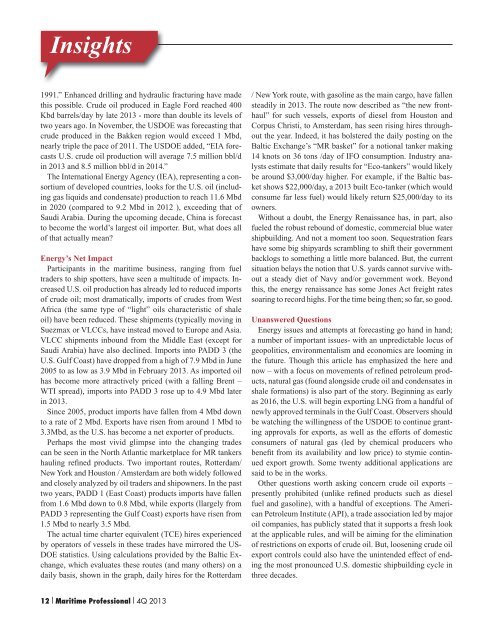1fjzeJ0
1fjzeJ0
1fjzeJ0
Create successful ePaper yourself
Turn your PDF publications into a flip-book with our unique Google optimized e-Paper software.
Insights1991.” Enhanced drilling and hydraulic fracturing have madethis possible. Crude oil produced in Eagle Ford reached 400Kbd barrels/day by late 2013 - more than double its levels oftwo years ago. In November, the USDOE was forecasting thatcrude produced in the Bakken region would exceed 1 Mbd,nearly triple the pace of 2011. The USDOE added, “EIA forecastsU.S. crude oil production will average 7.5 million bbl/din 2013 and 8.5 million bbl/d in 2014.”The International Energy Agency (IEA), representing a consortiumof developed countries, looks for the U.S. oil (includinggas liquids and condensate) production to reach 11.6 Mbdin 2020 (compared to 9.2 Mbd in 2012 ), exceeding that ofSaudi Arabia. During the upcoming decade, China is forecastto become the world’s largest oil importer. But, what does allof that actually mean?Energy’s Net ImpactParticipants in the maritime business, ranging from fueltraders to ship spotters, have seen a multitude of impacts. IncreasedU.S. oil production has already led to reduced importsof crude oil; most dramatically, imports of crudes from WestAfrica (the same type of “light” oils characteristic of shaleoil) have been reduced. These shipments (typically moving inSuezmax or VLCCs, have instead moved to Europe and Asia.VLCC shipments inbound from the Middle East (except forSaudi Arabia) have also declined. Imports into PADD 3 (theU.S. Gulf Coast) have dropped from a high of 7.9 Mbd in June2005 to as low as 3.9 Mbd in February 2013. As imported oilhas become more attractively priced (with a falling Brent –WTI spread), imports into PADD 3 rose up to 4.9 Mbd laterin 2013.Since 2005, product imports have fallen from 4 Mbd downto a rate of 2 Mbd. Exports have risen from around 1 Mbd to3.3Mbd, as the U.S. has become a net exporter of products.Perhaps the most vivid glimpse into the changing tradescan be seen in the North Atlantic marketplace for MR tankershauling refined products. Two important routes, Rotterdam/New York and Houston / Amsterdam are both widely followedand closely analyzed by oil traders and shipowners. In the pasttwo years, PADD 1 (East Coast) products imports have fallenfrom 1.6 Mbd down to 0.8 Mbd, while exports (llargely fromPADD 3 representing the Gulf Coast) exports have risen from1.5 Mbd to nearly 3.5 Mbd.The actual time charter equivalent (TCE) hires experiencedby operators of vessels in these trades have mirrored the US-DOE statistics. Using calculations provided by the Baltic Exchange,which evaluates these routes (and many others) on adaily basis, shown in the graph, daily hires for the Rotterdam/ New York route, with gasoline as the main cargo, have fallensteadily in 2013. The route now described as “the new fronthaul”for such vessels, exports of diesel from Houston andCorpus Christi, to Amsterdam, has seen rising hires throughoutthe year. Indeed, it has bolstered the daily posting on theBaltic Exchange’s “MR basket” for a notional tanker making14 knots on 36 tons /day of IFO consumption. Industry analystsestimate that daily results for “Eco-tankers” would likelybe around $3,000/day higher. For example, if the Baltic basketshows $22,000/day, a 2013 built Eco-tanker (which wouldconsume far less fuel) would likely return $25,000/day to itsowners.Without a doubt, the Energy Renaissance has, in part, alsofueled the robust rebound of domestic, commercial blue watershipbuilding. And not a moment too soon. Sequestration fearshave some big shipyards scrambling to shift their governmentbacklogs to something a little more balanced. But, the currentsituation belays the notion that U.S. yards cannot survive withouta steady diet of Navy and/or government work. Beyondthis, the energy renaissance has some Jones Act freight ratessoaring to record highs. For the time being then; so far, so good.Unanswered QuestionsEnergy issues and attempts at forecasting go hand in hand;a number of important issues- with an unpredictable locus ofgeopolitics, environmentalism and economics are looming inthe future. Though this article has emphasized the here andnow – with a focus on movements of refined petroleum products,natural gas (found alongside crude oil and condensates inshale formations) is also part of the story. Beginning as earlyas 2016, the U.S. will begin exporting LNG from a handful ofnewly approved terminals in the Gulf Coast. Observers shouldbe watching the willingness of the USDOE to continue grantingapprovals for exports, as well as the efforts of domesticconsumers of natural gas (led by chemical producers whobenefit from its availability and low price) to stymie continuedexport growth. Some twenty additional applications aresaid to be in the works.Other questions worth asking concern crude oil exports –presently prohibited (unlike refined products such as dieselfuel and gasoline), with a handful of exceptions. The AmericanPetroleum Institute (API), a trade association led by majoroil companies, has publicly stated that it supports a fresh lookat the applicable rules, and will be aiming for the eliminationof restrictions on exports of crude oil. But, loosening crude oilexport controls could also have the unintended effect of endingthe most pronounced U.S. domestic shipbuilding cycle inthree decades.12 I Maritime Professional I 4Q 2013


